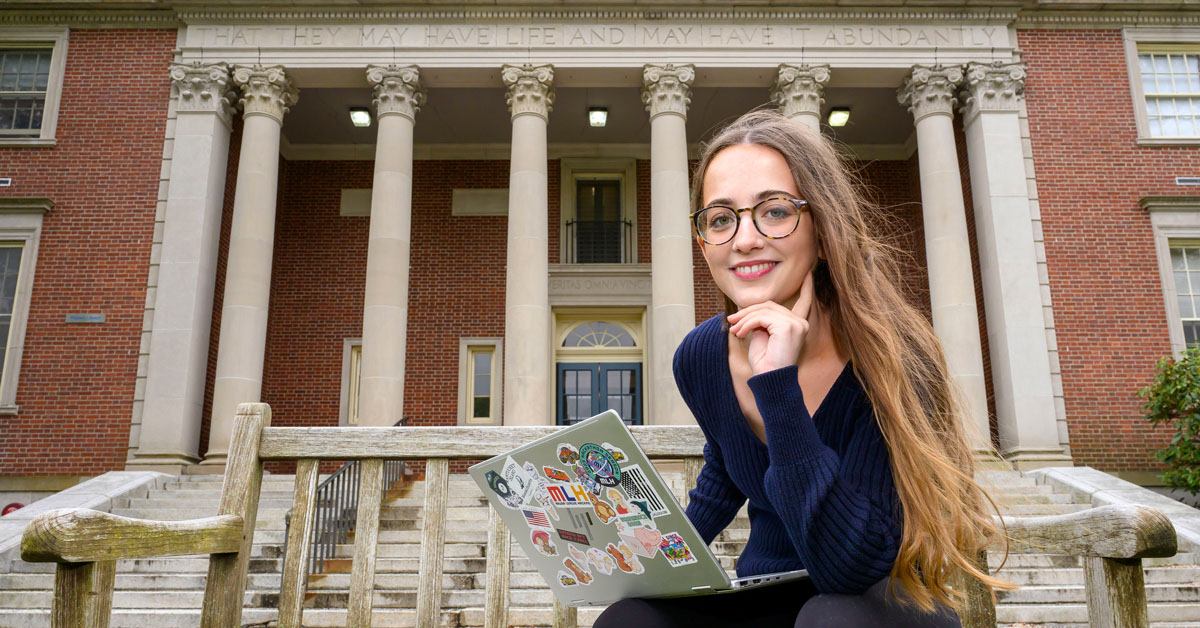Combining technology and medicine

Hackathon award winner Hanna Ondrasek ’26 recognized for project addressing healthcare need
Hanna Ondrasek could transform healthcare for professional caregivers and patients alike with computing tools that speed the way from diagnosis to treatment. In fact, she already has.
The Wheaton senior’s pilot program SkinSnap Baby evaluates infant skin conditions, offering a preliminary diagnosis for the cause of various rashes.
The online tool, which won a top prize at national hackathon competition in April, is available as a demonstration resource for parents, caregivers and the general public.
Hackathons are competitions which invite students from around the world to design and build technological solutions to solve problems.
A computer science major, Ondrasek became interested in healthcare through her work at the intersection of technology and medicine.
“Developing AI tools for diagnostics and safety systems showed me how innovation can directly improve lives, especially in underserved communities,” she said. “This inspired me to pursue a pre-med track, where I can combine technical knowledge with a commitment to patient-centered care.”
Through her work, Ondrasek has realized the potential of machine learning in healthcare.
“These experiences demonstrated a growing need for people who can bridge the gap between technical teams and healthcare providers, and that is a role I am eager to pursue through further study,” Ondrasek said.
For her recent hackathon project, she trained the model with images from verified medical case studies and rotated the images to improve the accuracy of the assessments. A teammate assisted with sourcing and organizing the training data for the project.
“I wanted to make something that parents could use, not just doctors,” Ondrasek explained, “where they could use their webcam and show my model the rash, and it could sort the rash into one of five categories.”
The web-based diagnostic tool can identify meningitis, sepsis, eczema, heat rash, and other skin conditions. Ondrasek said, “It’s not perfect because the amount of conditions it can identify is limited, but it’s a cool demo that could be helpful to the public.” Each user’s privacy is maintained by running the program exclusively through the browser.
“I think there’s a gap right now between the work of computer scientists and healthcare professionals,” she said. “My colleague and I are using AI and machine learning to detect skin cancer rashes at a higher accuracy level than top dermatologists can predict. AI can pick up on subtle differences between rashes that the human eye has difficulty detecting.”
Prior to April’s SharkHack event, Ondrasek developed a webcam-based machine learning model for predicting platelet count based on a rash at Harvard University’s “MakeHarvard 2025” competition.
“Many scientists have theorized that a severe rash with more little red dots probably correlates to a lower platelet count, and I was the first one to make a real machine learning model for that hypothesis.” She trained the model to scan an image and predict a platelet range. Its results are accurate about 90 percent of the time.
For both hackathon projects, Ondrasek used a diverse range of skin tones for the samples, which she believes helped to boost the accuracy of the assessments.
On campus, Assistant Professor of Computer Science Martin Gagné has provided support. “I’ve become a standout programmer because of Professor Gagné,” she said. “Without his classes and the way he teaches, I don’t think I could have done some of the things I do.
Major League Hacking, the national student hackathon league, sponsors more than 300 weekend-long competitions each year, where some 500,000 developers participate in either in-person or virtual events.
“I prefer the in-person hackathons, because I get to represent women,” said Ondrasek, estimating that only about 20 percent of participants are female. “Many people stereotype women as being incompetent in computer science. I find programming and shipping apps fun and interesting so I enjoy hackathons, but I also want to help combat stereotypes by winning or by having an impressive project.”
She has also spent three years as a student curator in the college’s computer museum. There, Ondrasek gained a mentor and an outlet to express herself. “Professor [of Computer Science Mark] LeBlanc has encouraged me and let me go in my own creative direction to display stories about women in computing. I appreciate that freedom.”
Ondrasek plans to attend more hackathons this summer, and hopes to continue using her knowledge and skills to help others, now and after she graduates next spring.
“I would like to do something philanthropic,” she said. “For example, I’m trying to create an opportunity where I would tutor SAT math for free for low-income students.”
